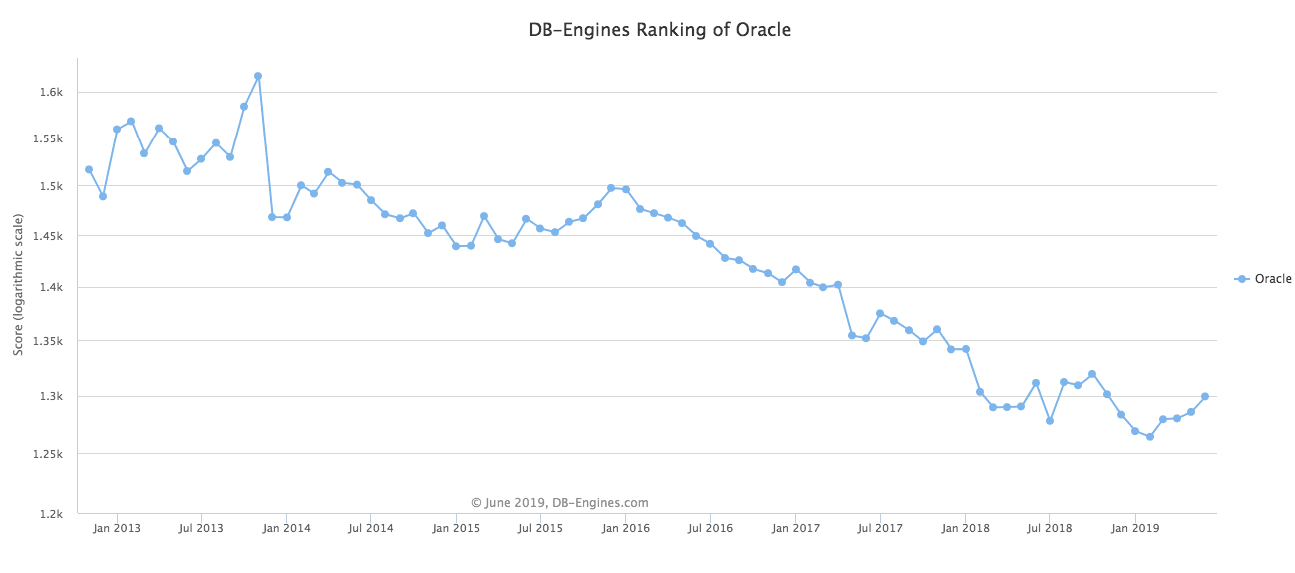Protected: Expanding Section: The Future of the Oracle Database
In addition to countering AWS RDS, the Autonomous Database is designed to keep some distance between the Oracle database and the open source databases, that have for most of the common uses, have caught up to the Oracle database, and already exceed it in terms of usability, and have a far lower initial cost as well as TCO.
The Value of the Oracle Database Versus Alternatives
Oracle’s database value vis-a-vis open source alternatives continues to decline. In effect, the rise of highly competent open source databases is commoditizing the database area, and this is true both in the category that Oracle’s database competes within as well as other categories. Larry Ellison has made the statement that the Oracle database is growing in market share as is evidenced by the following quote.
Oracle is Gaining Market Share?
“We also saw very rapid growth in sales of those database options required to run our Autonomous Database. We continue to gain overall database market share as we migrate our database users to the cloud.”
The Oracle database is not gaining market share. It has been slowly losing market share for more than five years.

The following is from DB Engines, which tracks database usage. This graph makes Oracle’s decline look larger than it is, as the base of the graph is not set to zero. However, if we look at the high point of October 2013, (which is roughly 1.625k), and use the most recent value (of 1.3k) the Oracle database has lost roughly 17% of its popularity.
However, while Oracle’s market share is slowly eroding, Oracle keeps a great deal of its installed base of databases for the following reasons.
Factors Working Against Oracle Losing its Database Market Share
| Factor | Factor Description |
|---|---|
| Code Placed in the Database | Oracle encouraged customers to place or push application code into the database. This is reduced the portability between databases of any application written on the database. Migration to a different (non-Oracle) database means removing the code from the database and placing it back in the application layer. |
| Misinformation and Legal Posturing | Oracle fights back against using virtualization, that allows fewer processors licenses to be used for databases by stating that using virtualization is a violation of the license agreement, when in fact it is not. |
| Control Over the Group Pricing | Any change which results in reduced income from Oracle is normally met by threats and revisiting the entire product or support bill of material. |
| Oracle Oriented IT Departments | Oracle IT departments often help keep Oracle solutions in place. This prevents movement away from Oracle even when it would lead to better outcomes if a change from Oracle was made. |
| General Application Certification | Applications often certify just a limited number of commercial databases. Oracle is one of them. And normally commercial vendors only certify commercial databases. |

Our Recommendation to Oracle Customers
In addition to performing the type of research you are currently reading, we advise companies on how to get better value from their Oracle investment, and in most cases, we recommend reducing their reliance on Oracle and on using Oracle support. Once you look at the costs of Oracle, the results are obvious.
But Oracle’s database is often sticky, even in areas where it could be replaced quite easily but an open source alternative, if Oracle had not already been put into place.
The synopsis is that Oracle is keeping much of the database market share that it is, because of the lock-in of the database. But Oracle is not picking up many new customers for the Oracle database, and its market share is destined to erode over time. Oracle’s attempt to differentiate their database by adding further bells and whistles (Oracle’s long term strategy up to this point), will yield decreasing benefits in the future.